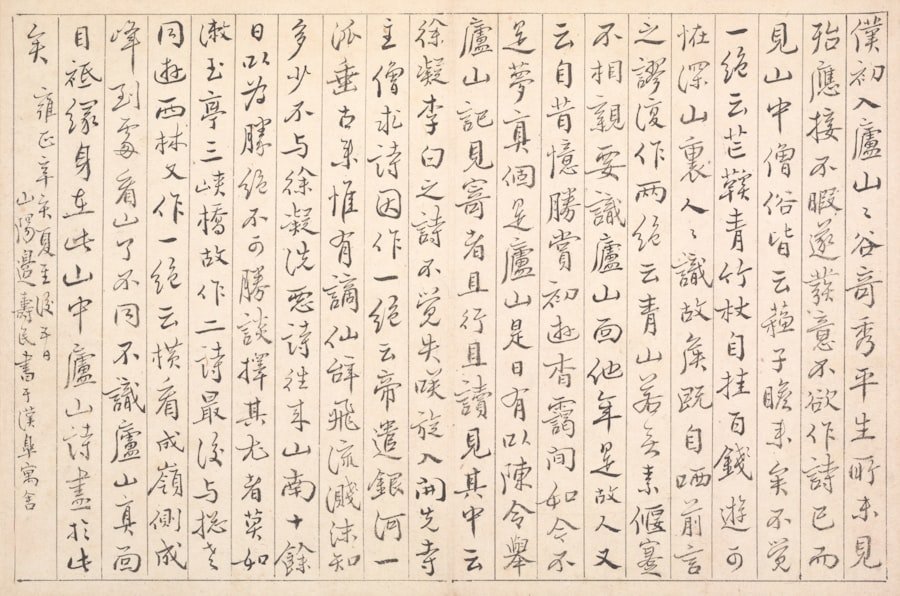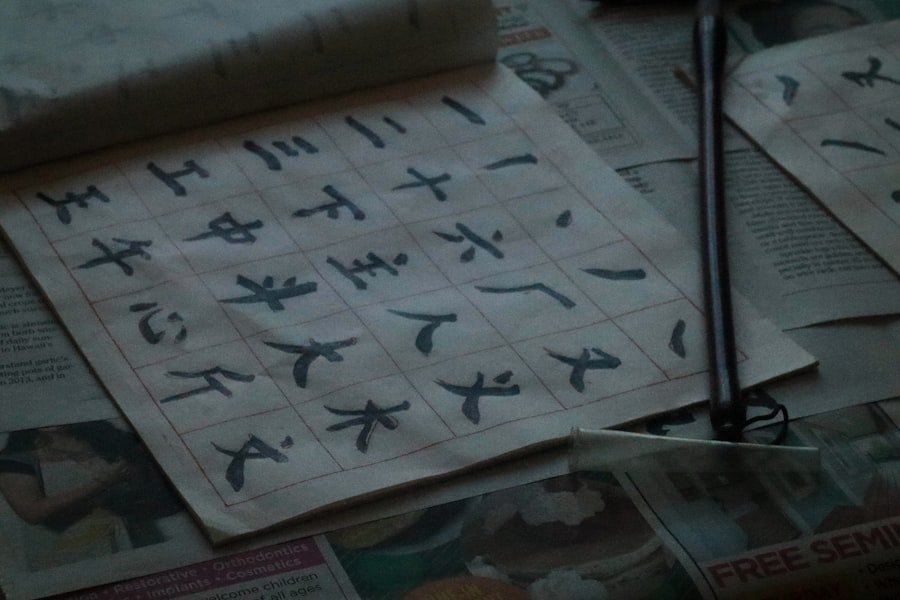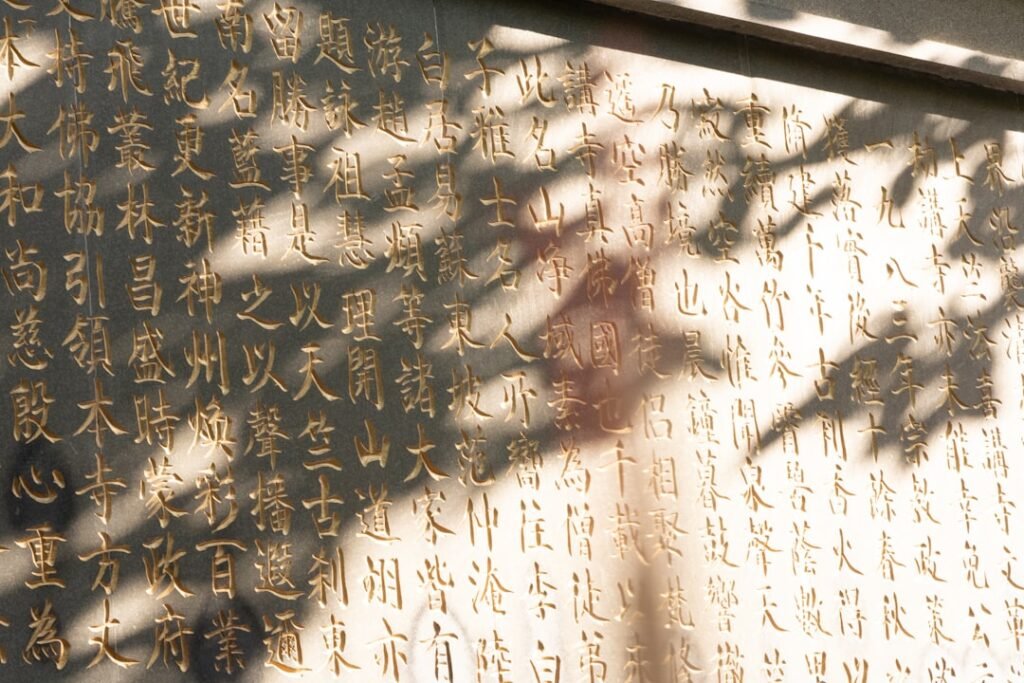Chinese calligraphy, an art form that has flourished for thousands of years, is deeply rooted in the cultural and philosophical traditions of China. Its origins can be traced back to the Shang Dynasty (c. 1600–1046 BCE), where inscriptions on oracle bones marked the beginning of written communication.
Over the centuries, calligraphy evolved, influenced by various dynasties and the philosophies of Confucianism, Taoism, and Buddhism. Each of these schools of thought contributed to the understanding of calligraphy not merely as a means of communication but as a profound expression of one’s inner self and connection to the universe. The philosophy behind Chinese calligraphy is intertwined with the concept of ‘Qi’ or life force, which flows through all living things.
Calligraphers believe that the brush strokes are a manifestation of this energy, reflecting the artist’s emotions, thoughts, and spiritual state. The practice is seen as a meditative process, where the act of writing becomes a dialogue between the mind and the universe. This philosophy elevates calligraphy beyond mere aesthetics; it becomes a spiritual journey that fosters self-awareness and personal growth. Master the art of Chinese calligraphy. Enroll now at the LC Chinese School in Oslo.
Table of Contents
ToggleSummary
- Chinese calligraphy has a rich history and is deeply rooted in philosophy, reflecting the cultural and spiritual values of the Chinese people.
- The mind-body-spirit connection in Chinese calligraphy emphasizes the holistic approach to art, focusing on the unity of the three elements for a harmonious practice.
- The flow and movement of Chinese calligraphy are essential, as they reflect the artist’s inner state and emotions, creating a unique and personal expression.
- Techniques for connecting mind, body, and spirit in Chinese calligraphy involve mindfulness, concentration, and a deep understanding of the characters being written.
- Breath and meditation play a crucial role in Chinese calligraphy, helping the artist to achieve a state of calm and focus, enhancing the therapeutic benefits of the practice.
Understanding the Mind-Body-Spirit Connection in Chinese Calligraphy
At the heart of Chinese calligraphy lies a profound connection between the mind, body, and spirit. This triad is essential for achieving harmony in the practice, allowing the calligrapher to express their innermost thoughts and feelings through brush strokes. The mind must be calm and focused, free from distractions, while the body must be relaxed yet poised, ready to translate mental clarity into physical movement.
The spirit, often seen as the guiding force, infuses each stroke with intention and emotion. This connection is not merely theoretical; it is cultivated through practice. As one engages with the brush and ink, they enter a state of flow where time seems to dissolve, and the outside world fades away.
In this space, the calligrapher can explore their creativity and express their individuality. The act of writing becomes a form of meditation, where each stroke serves as a reminder of the interconnectedness of all things. This holistic approach to calligraphy fosters a deeper understanding of oneself and one’s place in the world.
The Flow and Movement of Chinese Calligraphy

The flow and movement inherent in Chinese calligraphy are what set it apart from other forms of writing. Each brush stroke is a dance, a fluid motion that captures the essence of the calligrapher’s spirit. The brush itself becomes an extension of the artist’s hand, allowing for a dynamic interplay between pressure, speed, and direction.
This movement is not only physical but also emotional; it conveys feelings ranging from joy to sorrow, serenity to chaos. Understanding this flow requires practice and patience. Calligraphers often spend years honing their skills, learning to control their movements while allowing for spontaneity.
The beauty of Chinese calligraphy lies in its imperfections; each stroke tells a story, revealing the artist’s journey and emotional landscape. This emphasis on movement encourages practitioners to embrace their unique style, fostering a sense of individuality within the traditional framework of calligraphy.
Techniques for Connecting Mind, Body, and Spirit in Chinese Calligraphy
To fully connect the mind, body, and spirit in Chinese calligraphy, practitioners can employ various techniques that enhance their experience. One effective method is to begin each session with a moment of stillness. Taking time to breathe deeply and centre oneself allows for a clearer mental state, setting the stage for creativity to flow freely.
This practice not only calms the mind but also prepares the body for the physical demands of calligraphy. Another technique involves visualisation. Before putting brush to paper, practitioners can visualise their intentions for the session—whether it be expressing gratitude, exploring emotions, or simply enjoying the act of creation.
This mental preparation aligns the mind with the spirit’s purpose, creating a harmonious environment for artistic expression. Additionally, incorporating gentle stretches or movements can help release tension in the body, further enhancing the connection between mind and body.
The Role of Breath and Meditation in Chinese Calligraphy
Breath plays a pivotal role in Chinese calligraphy, serving as both a grounding force and a source of inspiration. The act of breathing deeply helps to calm the mind and centre one’s thoughts, creating an ideal mental state for artistic expression. As practitioners inhale and exhale slowly, they can synchronise their breath with their brush strokes, allowing for a natural rhythm to emerge in their writing.
Meditation is another essential component of this practice. Engaging in mindfulness meditation before beginning a calligraphy session can help clear mental clutter and foster a sense of presence. By focusing on the breath and letting go of distractions, practitioners can enter a meditative state that enhances their connection to both their inner selves and the art form itself.
This combination of breath and meditation transforms calligraphy into a holistic practice that nurtures both creativity and spiritual growth.
The Healing and Therapeutic Benefits of Chinese Calligraphy

The therapeutic benefits of Chinese calligraphy are increasingly recognised in contemporary society. Engaging in this art form can serve as a powerful tool for emotional healing and self-discovery. The act of writing allows individuals to express feelings that may be difficult to articulate verbally, providing an outlet for emotions such as stress, anxiety, or grief.
As practitioners immerse themselves in the rhythmic flow of brush strokes, they often experience a sense of release and catharsis. Moreover, calligraphy encourages mindfulness—a state of being present in the moment that has been shown to reduce stress levels and promote overall well-being. The focus required during practice helps individuals disconnect from external pressures and reconnect with themselves.
This therapeutic aspect makes Chinese calligraphy not only an art form but also a valuable practice for mental health and emotional resilience.
Incorporating Chinese Calligraphy into Mindfulness and Meditation Practices
Integrating Chinese calligraphy into mindfulness and meditation practices can enhance both experiences significantly. By approaching calligraphy with mindfulness, practitioners can deepen their awareness of each stroke and its significance. This heightened awareness transforms writing into a meditative ritual where every movement becomes intentional and meaningful.
To incorporate calligraphy into mindfulness practices, one might begin by setting aside dedicated time for both meditation and writing. Starting with a few minutes of mindful breathing can help establish a calm mental state before transitioning into calligraphy. As practitioners write, they can focus on their breath, allowing it to guide their movements and infuse each stroke with intention.
This synergy between mindfulness and calligraphy creates a rich tapestry of self-expression that nurtures both creativity and inner peace.
Chinese Calligraphy as a Form of Self-Expression and Creativity
Chinese calligraphy is not merely an art form; it is also a profound means of self-expression. Each brush stroke reflects the artist’s personality, emotions, and experiences, making every piece unique. This individuality is celebrated within the tradition; rather than striving for perfection, practitioners are encouraged to embrace their distinct styles and interpretations.
The creative potential within Chinese calligraphy is vast. Artists can experiment with different styles—such as Kaishu (regular script), Xingshu (running script), or Caoshu (grass script)—each offering its own aesthetic qualities and emotional resonance. This freedom allows practitioners to explore their creativity while remaining connected to cultural heritage.
As they engage with this art form, individuals often discover new facets of themselves, leading to personal growth and self-discovery.
The Spiritual and Cultural Significance of Chinese Calligraphy
Chinese calligraphy holds deep spiritual and cultural significance within Chinese society. It is often regarded as one of the highest forms of art due to its ability to convey profound philosophical concepts through visual expression. Calligraphers are seen as custodians of culture; their work preserves history while also reflecting contemporary values and beliefs.
The spiritual aspect of calligraphy is equally important. Many practitioners view their work as an offering—a way to connect with higher powers or express gratitude for life’s blessings. This spiritual dimension adds depth to each piece created; it becomes not just an artwork but also a vessel for intention and meaning.
In this way, Chinese calligraphy transcends mere aesthetics; it embodies cultural heritage while fostering personal spirituality.
Finding Balance and Harmony through the Practice of Chinese Calligraphy
The practice of Chinese calligraphy offers an opportunity to find balance and harmony in one’s life. As practitioners engage with this art form, they learn to cultivate patience, focus, and discipline—qualities that extend beyond the studio into everyday life. The rhythmic nature of brush strokes encourages a sense of flow that can be calming amidst life’s chaos.
Moreover, calligraphy serves as a reminder of the importance of balance between mind, body, and spirit. By dedicating time to this practice, individuals create space for self-reflection and personal growth. This journey towards balance fosters resilience in facing challenges while nurturing creativity and self-expression.
Tips for Beginners to Start Connecting Mind, Body, and Spirit Through Chinese Calligraphy
For those new to Chinese calligraphy seeking to connect mind, body, and spirit through this art form, several tips can facilitate an enriching experience. Firstly, start with quality materials—a good brush, ink, paper, and an appropriate workspace can significantly enhance your practice. Creating an inviting environment will help you feel more connected to your work.
Secondly, approach your practice with an open heart and mind. Allow yourself to explore without judgment; embrace imperfections as part of your journey rather than obstacles to overcome. Regularly set aside time for practice—consistency will help you develop your skills while deepening your connection to this ancient art form.
Lastly, consider joining courses or workshops at institutions like LC Chinese School in Oslo that offer specialised training in Chinese calligraphy. These courses provide structured guidance from experienced instructors who can help you navigate your artistic journey while fostering connections with fellow enthusiasts. In conclusion, Chinese calligraphy is more than just an art form; it is a holistic practice that nurtures the mind-body-spirit connection while offering profound opportunities for self-expression and creativity.
By engaging with this ancient tradition at places like LC Chinese School in Oslo, individuals can embark on a transformative journey that enriches their lives both artistically and spiritually.
Master the art of Chinese calligraphy. Enroll now at the LC Chinese School in Oslo.







